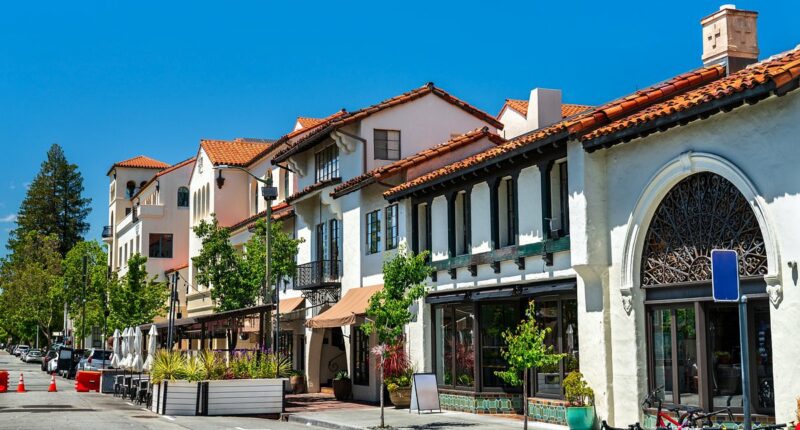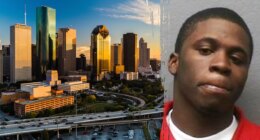Share this @internewscast.com
In a city known for its tech-savvy residents, an unexpected issue has taken center stage—residents are up in arms over the blaring train horns that disrupt their sleep.
In Palo Alto, home to notable figures like Meta’s CEO Mark Zuckerberg since 2004, the roar from Caltrain tracks has been a persistent irritation for many years.
As trains near the city’s railroad crossings, the piercing blast of the horn reaches nearly 110 decibels, a volume that can potentially cause hearing damage even with short-term exposure.
This horn, comparable in noise to a crowded nightclub or rock concert, is not just sounded once but is repeated four times as a warning to pedestrians and vehicles.
Fed up with the incessant noise, residents voiced their concerns at a recent city council meeting, where discussions centered on finding ways to mitigate the overwhelming sound.
During Monday’s meeting, local resident Rachel Croft shared her frustration, stating, “I have a new neighbor with a five-year-old who wakes up with that freight train in the middle of the night every single night.”
Two of the possible solutions discussed were introducing wayside horns, which would blare at the three Caltrain crossings, or a four-quadrant gate system.
Council member Pat Burt told the Daily Mail: ‘It’s a stationary horn at the crossing, rather than a horn on the train.

A Caltrain electric commuter train traveling beneath an overpass at a railroad crossing. As these trains approach crossings in Palo Alto, a deafening horn is blared at almost 110 decibels

Ramona Street Architectural District in downtown Palo Alto

A graphic showing five of Zuckerberg’s properties that sit next door to each other
‘The wayside horns reduce the noise by, like, 80-90 percent, so it’s very significant.’
A four-quadrant gate would completely eradicate any sound. The system fully blocks traffic from entering the tracks when a train is approaching, providing a higher level of safety than a standard two-gate setup.
Burt said installing the horn would be faster and cheaper, while building a four-quad gate is more expensive and can cost up to $5.1 million.
Croft emphasized that residents are ‘looking to eliminate the noise, not move and concentrate it.’
Other residents expressed the same complaints and declared their favor for the four-quad gate system.
The city ruled in favor of building the new gate system at Monday’s meeting, leaving Croft and others ‘very happy [for] an unanimous decision.’
Burt told Daily Mail: ‘This train has been here for over 150 years. I don’t know how long they’ve been blasting the horns, but this will be the first time in many, many, many decades that we won’t have horn noise in the community.’
The next step is securing funding for the project, which is posing an issue.

The Caltrain crossing in Melo Park, California, near Palo Alto

A general view of the campus of Stanford University including Hoover Tower as seen from Stanford Stadium, the renowned university is located in Palo Alto

Aerial view over Menlo Park suburb looking out to Palo Alto in Silicon Valley at sunset
‘The only real hurdle is we have to come up with the funding for the quiet zones,’ Burt said.
He added that the Valley Transportation Authority may be a funding source but it ‘hasn’t been determined yet.’
Burt also noted that receiving approvals from the California Public Utilities Commission for the project could cause delays too.
City senior engineer Ripon Bhatia estimates the project will take 36 to 60 months to complete, which has disappointed residents.
Local John Melnychuk said in the meeting: ‘Our next ask is to [build] it quickly… we [already] wasted a year talking about wayside horns which are obsolete.’
But there are some things that are being sorted immediately by Caltrain that will improve safety and security before the gates are installed.
Sturdy posts, solar-lit markers, and fresh road paint are being added to stop drivers from accidentally drifting onto the tracks.
And a new Rail Sentry system, which uses cameras, LIDAR and AI – the same tech found in self-driving cars – will be introduced to spot anyone or anything on the tracks.

Mark Zuckerberg, CEO of Meta, owns at least 11 houses in the Crescent Park neighborhood of Palo Alto

An aerial view of one of Zuckerberg’s properties. He moved to Palo Alto in 2004
If it detects danger, it alerts dispatchers within seconds so trains can be stopped.
The agency is also adding European-style anti-intrusion mats, 10ft-wide panels laid across the corridor, along with secure fencing to stop people from walking onto the tracks.
‘By the first week of January we will have installed the safety measures that will make it much safer than it’s ever been,’ Burt told the Daily Mail.
Palo Alto, often referred to as the ‘Birthplace of Silicon Valley’ due to its role in fostering the growth of numerous technology companies, is one of the most expensive California cities to live in.
Home to Stanford University, one of the world’s leading research universities, many prominent tech companies, such as Facebook, Google, and Hewlett-Packard, have their headquarters or a significant presence in Palo Alto.
The city consistently ranks among the top cities in the United States in terms of quality of life and overall livability – but getting a home there is out of reach for many.
The average Palo Alto home value is a blistering $3,483,080 according to Zillow. This is not unusual for the housing market in the Golden state.
California is home to the five most expensive markets by median sale price in 2025, according to a SmartAsset research.

The front view of Zuckerberg’s estate, he spent at least over $43 million on Palo Alto homes over the past 15 months

The Caltrain Station in San Francisco. These trains’ horns are so loud that it disrupts residents sleep each night
Billionaire Zuckerberg and his wife, Priscilla Chan, first moved to the Crescent Park neighborhood of Palo Alto in 2011, but residents said he completely upended the once idyllic area to build his own private compound.
The pair purchased the oldest house in the city, a 5,600sq ft home on Edgewood Drive.
Then Zuckerberg started buying up more and more property along Edgewood Drive and Hamilton Avenue, spending more than $110 million to scoop up at least 11 houses – several of which now sit empty.
The tech tycoon has bought four homes in the past 15 months and spent over $43 million to combine them into his private 1.83-acre estate in Palo Alto, according to Robb Report.





